
Risk sentiment deteriorated sharply in the second half of the week after President Donald Trump announced sweeping tariffs on imported automobiles, compounding concerns about rising inflationary pressures.
On Wednesday evening, the White House revealed plans to impose a 25% tariff on auto imports, in addition to a set of reciprocal tariffs expected to be unveiled next week. The administration cited national security risks as the justification for the measures, which may also extend to auto parts by May.
The policy shift sent shockwaves across the automotive industry. Michigan-based giants General Motors Co. GM and Ford Motor Co. F posted steep losses in the wake of the announcement. In contrast, Tesla Inc. TSLA and Rivian Automotive Inc. RIVN — both of which manufacture all their vehicles domestically — proved more resilient.
According to Goldman Sachs estimates, the tariffs could push vehicle prices up by $5,000 to $15,000, adding significant cost pressure on American consumers.
The market impact didn’t stop at autos. Broader sectors were also dragged lower amid fears Trump could escalate trade tensions next week with key commercial partners, especially as the U.S. trade deficit remains near record highs.
Tariff tensions are now bleeding into inflation data. The Fed’s preferred inflation gauge — the core Personal Consumption Expenditures price index — rose 2.8% year-over-year in February, surpassing expectations of 2.7%. The unexpected acceleration further complicates the Federal Reserve’s case for near-term rate cuts.
But the worst surprise came Friday. The University of Michigan’s consumer survey revised inflation expectations even higher. Americans now expect inflation to average 4.1% over the next five years, up 0.2 percentage points from earlier estimates and the highest level since February 1993.
Overall consumer sentiment plunged to its lowest level since November 2022, as households grow increasingly uneasy about the labor market outlook.
Amid the prevailing uncertainty, gold reaffirmed its status as a safe-haven asset, climbing to new record highs by week’s end.
Meanwhile, the Congressional Budget Office delivered another wake-up call: there’s no end in sight to America’s growing debt burden. The national debt is projected to surpass its World War II peak by 2029, and soar to 156% of GDP by 2055 — with no signs of slowing thereafter.
Read now:
Photo: janews via Shutterstock
Momentum31.43
Growth78.94
Quality–
Value90.80
Market News and Data brought to you by Benzinga APIs
© 2025 Benzinga.com. Benzinga does not provide investment advice. All rights reserved.


